Content for TS 23.273 Word version: 19.1.0
1…
4…
4.2…
4.2a…
4.3…
5…
5.5…
6…
6.1.2
6.1.3
6.1.4…
6.2
6.3…
6.3.2…
6.4
6.5…
6.7…
6.7.3
6.7.4
6.7.5
6.8
6.9…
6.10…
6.11…
6.12…
6.13…
6.14…
6.15…
6.16…
6.17…
6.18…
6.19…
6.19.2…
6.20…
6.20.4…
6.21…
7…
8…
A…
B…
C…
6.21 Procedure for NWDAF assistance to location services
6.21.0 General
6.21.1 Location Accuracy Analytics Retrieval by LMF
6.21.2 UE Mobility Analytics Retrieval by AMF
6.22 Procedures of data collection for LMF-based AI/ML Positioning
6.22.1 General
6.22.2 Data Collection at LMF for the LMF-based AI/ML positioning based on UE measurements
6.22.3 Data collection to train models for LMF-based AI/ML positioning based on NG RAN measurements
6.22.4 Input data collection by NWDAF for AI/ML positioning ML model training or ML model performance monitoring
6.22.5 LMF retrieval of a trained AI/ML Model for positioning
...
...
6.21 Procedure for NWDAF assistance to location services |R18| p. 154
6.21.0 General p. 154
This clause specifies procedures for NF in the LCS system to interact with NWDAF for data analytics. General framework for NF in the LCS system to interact with NWDAF for data analytics refers to the clauses 6.1.1 and 6.1.2 of TS 23.288.
Clause 6.21.1 describes the procedures of Location Accuracy Analytics retrieved by LMF.
Clause 6.21.2 describes the procedures of UE Mobility Analytics retrieved by AMF.
The procedure in Figure 6.21-1 can be used by a 5GC NF involved in 5GC location services to get optional assistance from NWDAF as shown below.
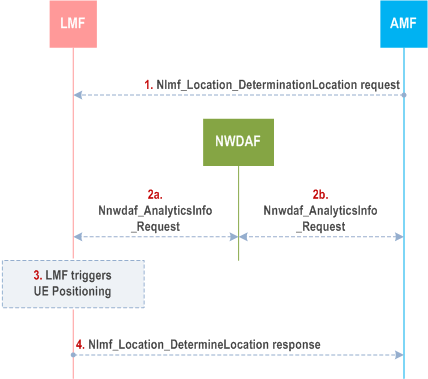
Step 1.
The AMF may invoke Nlmf_Location_DeterminationLocation service operation towards the LMF to request the current location of the UE.
Step 2.
Assistance from NWDAF for location services may be requested from the LMF and/or AMF.
Step 3.
The LMF may trigger UE positioning.
Step 4.
The LMF may return the location estimate to AMF as specified in clause 8.3.2.
6.21.1 Location Accuracy Analytics Retrieval by LMF p. 155
LMF may request Location Accuracy Analytics from NWDAF to retrieve the location accuracy.
The procedure to request Location accuracy analytics by LMF is referred to clause 6.17.4 of TS 23.288. In Figure 6.17.4-1 of TS 23.288 the Analytics consumer is replaced by LMF. Pre-condition of the procedure is NWDAF has a trained supervised ML model for deriving Location Accuracy Analytics.
6.21.2 UE Mobility Analytics Retrieval by AMF p. 155
AMF may request assistance for UE location verification for NR satellite access as described in clause 6.10.1 by requesting or subscribing to UE mobility analytics from NWDAF. With NWDAF-based UE location statistics and predictions and UE location estimated by LMF, AMF can further assist UE location verification for NR satellite access.
6.22 Procedures of data collection for LMF-based AI/ML Positioning |R19| p. 155
6.22.1 General p. 155
This clause describes the procedure for data collection by the LMF for input data to train or monitor the performance of the LMF-based AI/ML models for AI/ML-based positioning.
6.22.2 Data Collection at LMF for the LMF-based AI/ML positioning based on UE measurements p. 155
The LMF needs to obtain input data for LMF-based AI/ML Positioning model training, performance monitoring and may also request the UE to provide the UE location. The LMF-based AI/ML Positioning model is trained to perform UE positioning for UEs located in an area of interest that may expand over multiple TA or cover multiple NG-RAN nodes.
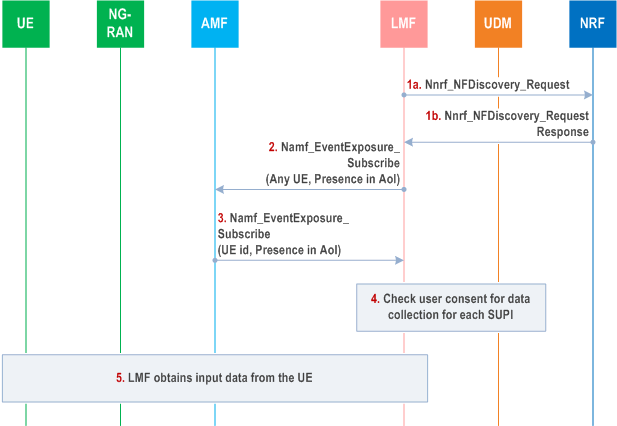
Figure 6.22.2-1: Data collection at LMF for the LMF-based AI/ML positioning based on UE measurements
Step 1.
At the time the LMF decides that the input data for a UE are not needed, e.g. the user consent for data collection for model training is revoked, the LMF stops to collect the input data from the UE.
The LMF starts data collection for the purpose to train an AI/ML Model for UE Positioning (this may be based on an internal trigger in the LMF or a request from the NWDAF). The LMF invokes an Nnrf_NFDiscovery_Request service operation to an NRF to discover AMF(s) that served for the area of interest.
Step 2.
The LMF subscribes to AMF to retrieve the list of SUPIs located in an area of interest and the UE Positioning Capability for each UE using Namf_EventExposure_Subscriber_Request (Target of Event Reporting = "any UE", Event ID = "UEs in/out area of interest" and "UE Positioning Capability".
Step 3.
The AMF send Namf_EventExposure_Subscriber_Response ("list of SUPIs in the area of interest"). If "UE Positioning Capability" is also requested in step 1, AMF includes UE Positing Capability, UE User Plane Positioning Capabilities if available for each SUPI in the response message sent to LMF.
Step 4.
The LMF further determines the UEs from the list of SUPIs that received from AMF in step 2 for data collection based on UE Positioning Capability, UE User Plane Positioning Capabilities, UE consent check result, the PRU information available in the LMF and operator's policy. The User consent check is not needed for data collection from PRU for performance monitoring.
Step 5.
For each UE that provides consent to data collection for model training and can support data collection the LMF initiates a request for input data. The UE may reject the data collection request from the LMF (e.g. considering UE status, user's input). If the UE accepts data collection request, the UE may cancel the data collection later as defined in clause 6.3.4.
6.22.3 Data collection to train models for LMF-based AI/ML positioning based on NG RAN measurements p. 157
The procedure for data collection from NG-RAN for LMF-based AI/ML positioning is used to e.g. train the AI/ML Model.
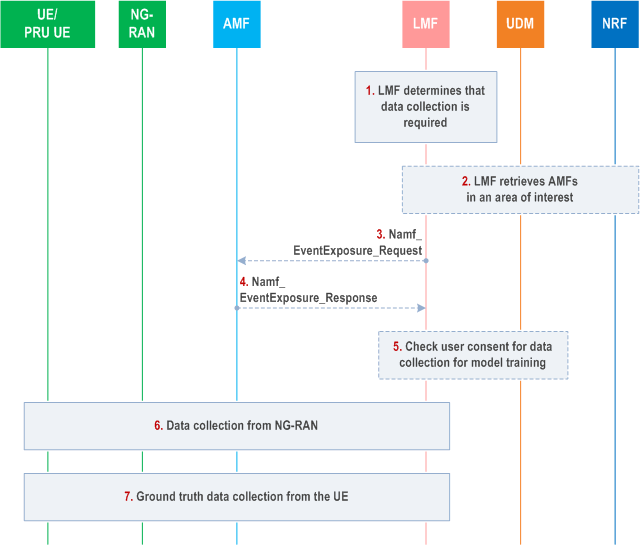
Step 1.
The measurements and ground truth data are used for training. The UE location is derived from the measurements data by using LMF-based AI/ML Positioning. The derived UE location and ground truth data are used for performance monitoring.
The LMF may initiate data collection for multiple UEs simultaneously, as such step 8 and 9 may occur in parallel for a number of SUPIs as determined by the LMF.
The LMF determines that data collection is required e.g. to train an AI/ML Model for UE positioning for a number of UEs or to monitor the AI/ML Model performance. The LMF may also initiate the data collection upon the request of an NWDAF containing MTLF as described in step 3 in Figure 6.22.4-1.
Step 2.
The LMF may know the SUPI of these UEs, e.g. when training a AI/ML model using a PRU, which are associated to this LMF that executes data collection, the LMF may optionally invoke an Nnrf_NFDiscovery Request service operation to an NRF in order to identify the LMF(s) which has PRU associated to a list of TAIs. The LMF may send an Nlmf_Location_MeasurementData Request service operation to one or more of the other PRU serving LMFs in order to get the data collection and the known PRU location in this case step 6 follows.
If the LMF does not know the SUPIs of those UEs, the LMF try to get the list of SUPIs from the AMF, before that the LMF finds the AMFs via NRF using Nnrf_NFDiscoveryRequest .
Step 3.
For each AMF serving a specific area. the LMF subscribes to retrieve the list of SUPIs located in an area of interest using Namf_EventExposure_Subscriber_Request (Target of Event Reporting = "any UE", Event ID = "UEs in/out area of interest".
Step 4.
The AMF send Namf_EventExposure_Subscriber_Response or Namf_EventExposure_Notify ("list of SUPIs in/out the area of interest").
For each SUPI provided by the AMF that is in the area of interest then steps 5 to step 6 are performed.
Step 5.
The LMF checks whether the SUPI provided user consent for data collection for the purpose of training with UDM. If user consent is provided, then step 6 follows. if user consent is not provided, the LMF does not perform step 6 for this UE, that will not be part of the data collection, and its data is not used for the LMF-based AI/ML Model positioning.
Step 6.
The LMF request input data for the target UE from NG-RAN.
Step 7.
The LMF receives ground truth data from the UE.
6.22.4 Input data collection by NWDAF for AI/ML positioning ML model training or ML model performance monitoring p. 158
The NWDAF containing MTLF may subscribe to input data (i.e. location measurement related data) from LMF for ML model training or ML model performance monitoring for LMF-based AI/ML Positioning.
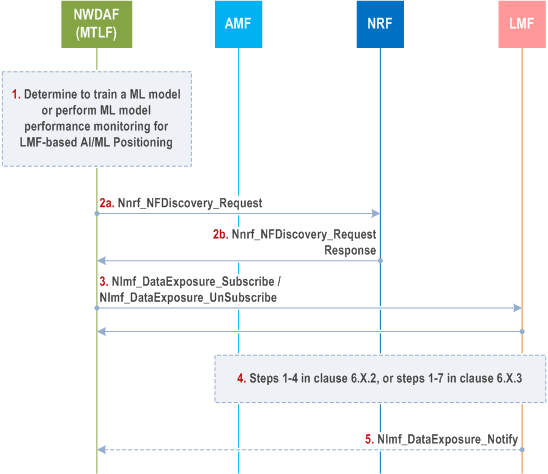
Step 1.
NWDAF containing MTLF determines to train a ML model for LMF-based AI/ML Positioning based on the request from LMF or internal trigger, or the NWDAF containing MTLF determines to perform ML model performance monitoring for LMF-based AI/ML Positioning.
Step 2.
The NWDAF invokes an Nnrf_NFDiscovery_Request service operation to an NRF to discover an LMF, the service operation includes an AoI and the Nlmf_DataExposure service as discovery parameters. If the NWDAF wants to collect the input data of PRUs, the NWDAF may also include a PRU existence indication for discovering the LMF(s) associated with PRUs (the PRU association procedures are defined in clause 6.17). The NRF selects one or more LMFs based on the AoI, the Nlmf_DataExposure service, and the PRU existence indication (if available), and sends an Nnrf_NFDiscovery_Request Response which includes the profiles of the selected LMFs to the NWDAF.
Step 3.
The NWDAF subscribes to or cancels subscription to input data from LMF by invoking Nlmf_DataExposure_Subscribe / Nlmf_DataExposure_UnSubscribe service operation. The NWDAF includes an AoI and a notification target address to request the input data from LMF. The NWDAF may also include requested number for data samples and time window for data collection.
Step 4.
The LMF performs steps 1 to 4 in clause 6.22.2, or steps 1 to 7 in clause 6.22.3.
Step 5.
The LMF sends the collected data samples to the NWDAF by invoking Nlmf_DataExposure_Notify service operation, then the NWDAF trains the ML model or performs ML model performance monitoring based on the data samples.
6.22.5 LMF retrieval of a trained AI/ML Model for positioning p. 159
The LMF may retrieve a trained AI/ML Model from NWDAF. The LMF obtains a trained AI/ML model prior to a UE positioning request that requires a trained ML Model.
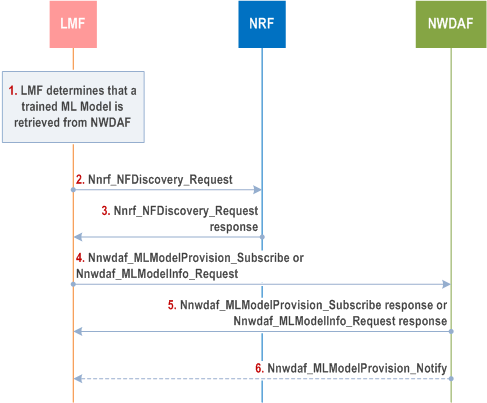
Step 1.
The LMF updates the received trained ML Model(s) when the NWDAF provides new ones.
The LMF determines using local policies, that a positioning method requires a trained ML Model, the trained ML Model is not trained locally but is retrieved from NWDAF.
Step 2.
The LMF discovers the NWDAF that can provide a trained model, using Nnrf_NFdiscovery including a request for AI/ML Model for UE positioning, ML Model Filter Information that includes the positioning case information and an Area(s) of Interest, the ML Model Interoperability indicator applicable to the trained ML Model for UE Positioning, optionally the ML Model Accuracy checking capability.
Step 3.
The LMF receives a list of candidates NWDAF instances, validity period for the discovery, per NWDAF instance the NWDAF instance ID, FQDN or IP address, and the ML Model Interoperability Indication.
Step 4.
The LMF selects a NWDAF out of the list of candidates NWDAF instances, that can provide a ML Model that supports the same ML Model Interoperability Indication then request a trained AI/ML Model using Nnwdaf_MLModelInfo_Request or Nnwdaf_MLModelProvision_Subscribe including the request for a trained AI/ML Model for UE Positioning according to the information listed in clause 5.18.
Step 5.
The NWDAF provides one or more AI/ML Models to LMF including a ML Model Identifier and the ML Model Information as described in clause 5.18.
Step 6.
Same as in step 5.